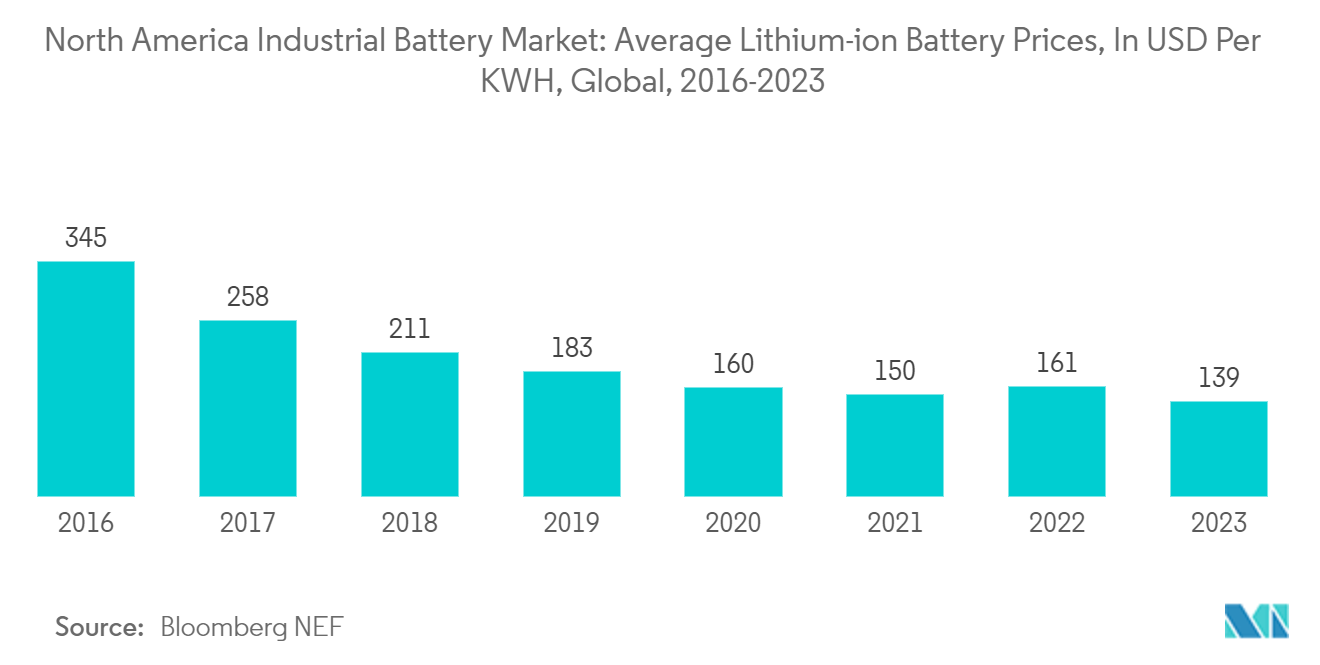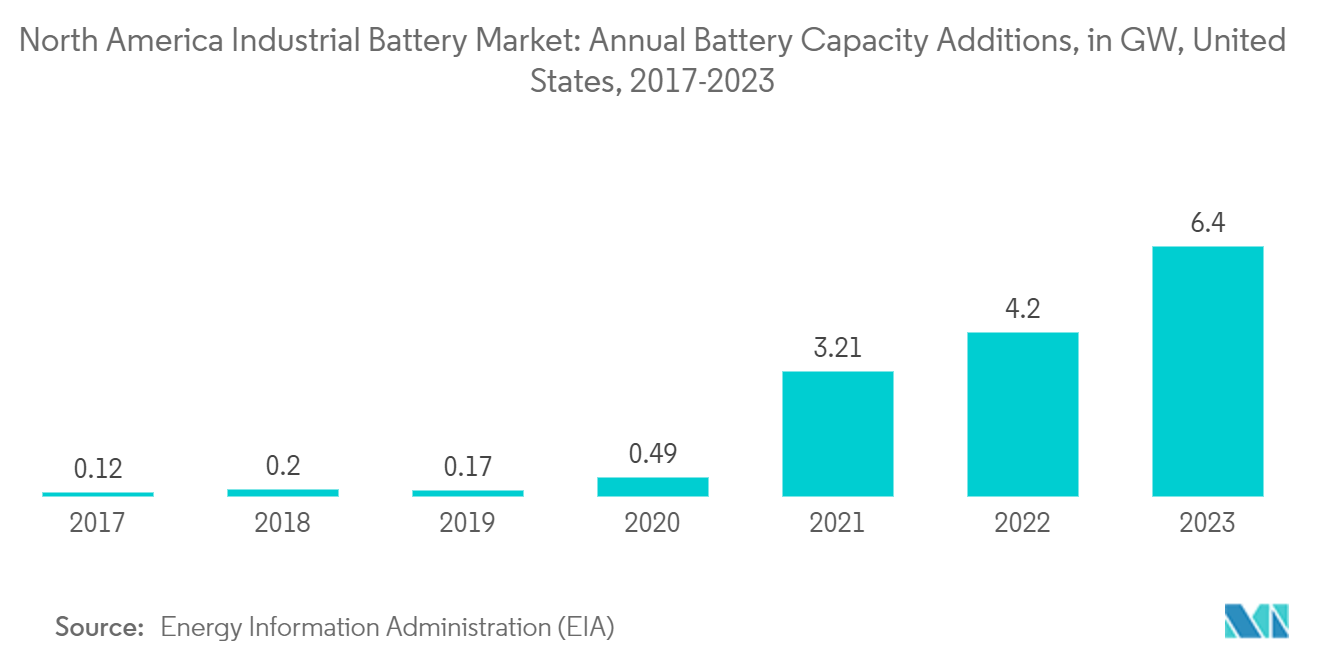Market Trends of North America Industrial Battery Industry
Lithium-ion Battery (LIB) Technology Projected to be the Fastest-growing Market Segment
- Among the different types of industrial battery technologies, the lithium-ion battery (LIB) type is expected to witness significant growth in the North American industrial batteries market over the forecast period, majorly due to its favorable capacity-to-weight ratio. Other factors boosting LIB adoption include properties like better performance, higher energy density, and decreasing price.
- Global lithium-ion battery manufacturers are focusing on reducing the cost of lithium-ion batteries. The price of lithium-ion batteries declined steeply over the past ten years. In 2023, the price of an average lithium-ion battery was valued at around USD 139 per kWh, having witnessed a decrease of more than 82% in the price compared to 2013. The decline in lithium-ion battery prices will encourage industrial battery manufacturers to mobilize the production of electronics, small and large appliances, UPS, and electrical energy storage systems at cheaper rates.
- In November 2023, the US government announced a funding of USD 3.5 billion under the ambit of its Infrastructure Law to expedite indigenous production of advanced batteries such as lithium-ion in the country. As a part of the Invest in America Agenda, government funding is expected to help lithium-ion cell and pack manufacturing capabilities over the coming years.
- Further, the United States has been witnessing the development of lithium-ion gigafactories in recent years. In February 2024, EnerSys noted the development of a square-foot lithium-ion battery manufacturing unit at the Augusta Grove Business Park in Greenville. By 2027, EnerSys plans to start manufacturing lithium-ion battery cells to cater to the demand for industrial and defense applications in the United States.
- Owing to the surge in the utilization of lithium-ion batteries across various industries, their safety is of immense importance in eliminating the possibility of uncontrolled self-heating instances and explosions. Such events are, however, rare for high-quality lithium-ion batteries, but it becomes critically important to hold safety checks.
- In February 2024, the National Research Council of Canada (NRC) announced the development of a testing technique to assess the single-cell thermal runaway failure of lithium-ion battery modules or packs. The patented mechanism known as the Thermal Runaway Initiation Mechanism (or TRIM) device can be used to test the design and components of lithium-ion batteries. This can significantly help the concerned regulators devise safety guidelines for battery users.
- Therefore, based on the abovementioned factors, lithium-ion battery technology is expected to witness significant demand and be the fastest-growing segment of the North American industrial batteries market during the forecast period.

United States Projected to Dominate the Market
- The United States is one of the major hotspots for industrial batteries worldwide on account of the surging deployment of battery-based energy storage projects, expansion in renewable power infrastructure, and a robust industrial infrastructure. Moreover, favorable policies backing the deployment of energy storage systems (ESS) in the United States are likely to drive the industrial batteries market over the coming years.
- The US battery energy storage systems (BESS) industry has been experiencing notable growth over the past few years, supported by rising investments in renewable energy infrastructure in the country. Over the past few years, the installed renewable energy capacity and generation have been rising steadily globally, and the United States is one of the global renewable energy hotspots.
- In 2023, according to the Energy Information Administration (EIA), the United States augmented its electric capacity with a significant addition of 6.4 gigawatts in battery storage, marking a notable 2.2 gigawatt increase over the previous year. This expansion underscored the country's commitment to enhancing its renewable energy infrastructure and reducing reliance on fossil fuels.
- According to the International Renewable Energy Agency (IRENA), during 2013-23, installed renewable energy capacity grew by more than two times, and as of 2023, the total installed renewable capacity stood at around 387.54 GW in the United States.
- According to the US Energy Information Administration, the US utility-scale battery storage capacity was expected to nearly double, with developers planning to add 14.3 GW to the 15.5 GW in 2023. In 2023, 6.4 GW of new battery storage capacity was added to the US grid, marking a 70% annual increase. Texas and California were expected to contribute 82% of the new capacity, with 6.4 GW and 5.2 GW, respectively.
- Moreover, 75% of the 20.8 GW of utility-scale battery capacity planned by developers to be installed from 2022 to 2025 is in Texas (7.9 GW) and California (7.6 GW).
- In the United States, the California Independent System Operator (CAISO) and Electric Reliability Council of Texas (ERCOT) have the most large-scale battery storage capacity additions. Over the past twelve months, battery capacity as a percentage of solar generation capacity in CAISO has significantly increased, climbing from 29% in January 2023 to 41% by December 2023.
- In addition, the government is also proactively assuring international ties to make a robust BESS industry in the United States. For instance, in December 2023, the European Commission, together with the national governments of Australia, the United States, and Canada, supported a new initiative to promote battery storage in the global transition to low-emission electricity.
- This initiative, announced during the COP28 UN Climate Conference, called the 'Supercharging Battery Storage Initiative,' originates from the Clean Energy Ministerial, which includes energy departments from numerous countries as members and participants. Such bilateral clean energy activities are expected to help the United States develop a robust market for battery energy storage systems.
- Therefore, based on the abovementioned factors, the United States is expected to dominate the North American industrial batteries market during the forecast period.


